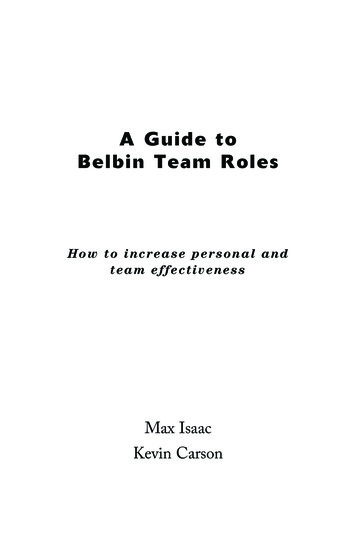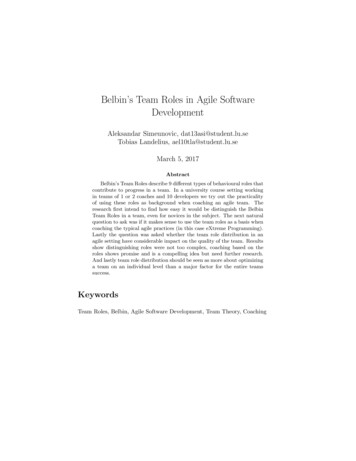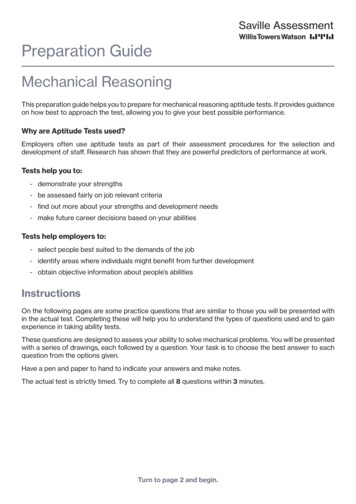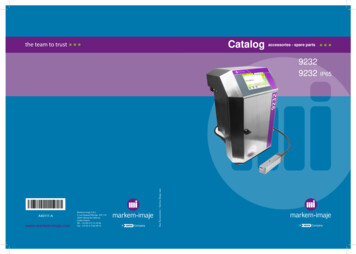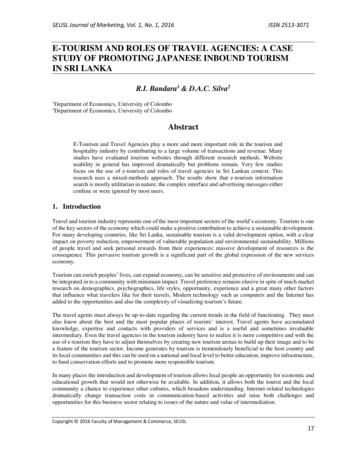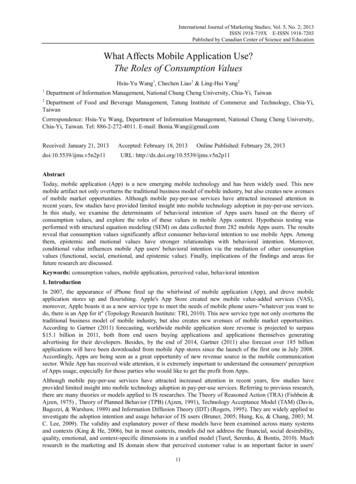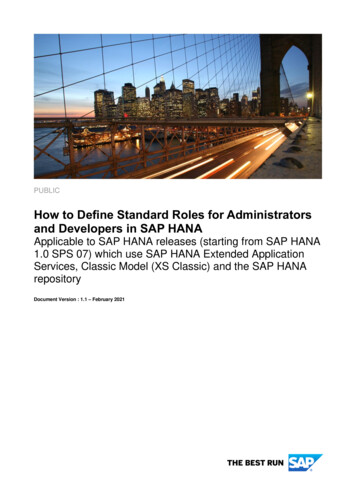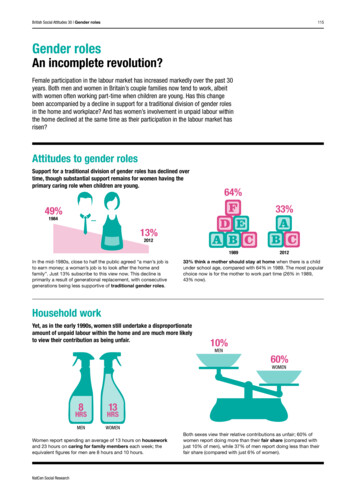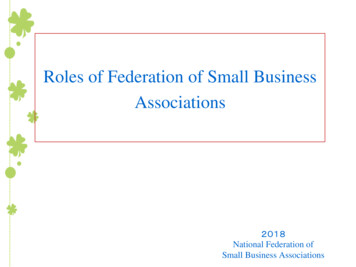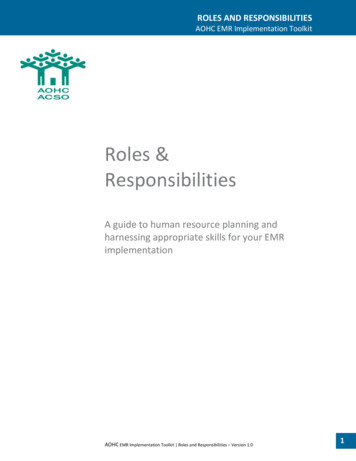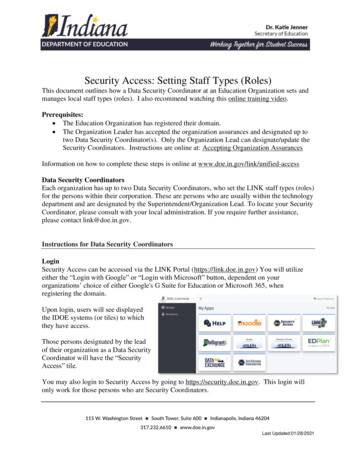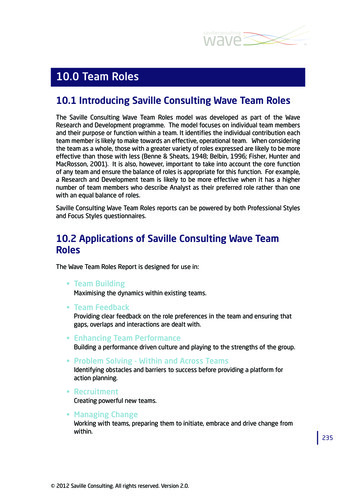
Transcription
10.0 Team Roles10.1 Introducing Saville Consulting Wave Team RolesThe Saville Consulting Wave Team Roles model was developed as part of the WaveResearch and Development programme. The model focuses on individual team membersand their purpose or function within a team. It identifies the individual contribution eachteam member is likely to make towards an effective, operational team. When consideringthe team as a whole, those with a greater variety of roles expressed are likely to be moreeffective than those with less (Benne & Sheats, 1948; Belbin, 1996; Fisher, Hunter andMacRosson, 2001). It is also, however, important to take into account the core functionof any team and ensure the balance of roles is appropriate for this function. For example,a Research and Development team is likely to be more effective when it has a highernumber of team members who describe Analyst as their preferred role rather than onewith an equal balance of roles.Saville Consulting Wave Team Roles reports can be powered by both Professional Stylesand Focus Styles questionnaires.10.2 Applications of Saville Consulting Wave TeamRolesThe Wave Team Roles Report is designed for use in: Team BuildingMaximising the dynamics within existing teams. Team FeedbackProviding clear feedback on the role preferences in the team and ensuring thatgaps, overlaps and interactions are dealt with. Enhancing Team PerformanceBuilding a performance driven culture and playing to the strengths of the group. Problem Solving - Within and Across TeamsIdentifying obstacles and barriers to success before providing a platform foraction planning. RecruitmentCreating powerful new teams. Managing ChangeWorking with teams, preparing them to initiate, embrace and drive change fromwithin.235 2012 Saville Consulting. All rights reserved. Version 2.0.
10.3 Model DevelopmentThe model was developed by splitting the Wave Wheel Performance Culture Frameworkclusters of Solving Problems, Influencing People, Adapting Approaches and DeliveringResults into two, leading to a total of eight core functions.Wheel 1: Wave Wheel - Team Roles MappingProviding the teamwith reassuranceand ATORSocuFntioia bleSUPPORTERiveginatImaSupSup portiveporterOPTIMISTC o n scieGets task completedefficiently todeadlinesInvesteblxiiveatigProviding supportand help to otherteam membersConvergentproblem solvingEvaluativeProviding creativityand creativesolutionsCommunicatingwithin and outsidethe teamsinisherlucASSERTORfurStSTRIVERPushes the teamtowards ambitiousachievementsctturedImD rivenAssee rtivpaProviding team withdirection and focusTwo models were aligned to this framework to compare and contrast similarities anddifferences; the Great Eight (Kurz and Bartram, 2002) and the Belbin Team Model (Belbin,1996).236 2012 Saville Consulting. All rights reserved. Version 2.0.
Wheel 2: The Saville Consulting Wave Team Roles Model and theGreat EightisttimOpAnalyzing &InterpretingOrganizing &ExecutingInteracting &PresentingrCreating &ConceptualizingrReshelatoFiniSupporting &CooperatingtorovaInnSupporterAdapting& CopingAnalystEnterprising& PerformingStrivLeading& DecidingerAsser torWheel 2 shows the direct alignment between the Great Eight and the Saville ConsultingWave Team Roles model. The Great Eight model (Kurz & Bartram, 2002) was one of theoriginal inputs into the development of the Wave Performance Culture Framework anddeployed in the Project Epsom research study (MacIver et al., 2008). Exactly the sameGreat Eight equations were now adopted for the eight Team Roles constructs thuseffectively providing practitioners and researchers with Great Eight scores from SavilleConsulting Wave.Table 10.1 shows a rational alignment between the Saville Consulting Wave Team Rolesmodel and the Belbin Team Roles model (1996).Team INATOR-CHAIROPTIMIST(NO COVERAGE)SUPPORTERTEAM SHAPER 2012 Saville Consulting. All rights reserved. Version 2.0.237
Table 10.1 Saville Consulting Wave Team Roles model and BelbinTable 10.1 displays the high degree of correspondence between the two models with themajority of Saville Consulting Wave Team Roles having a direct counterpart in Belbin’smodel. However, the differences between the Wave Team Roles and the Belbin modelsare also worthy of note. The first difference is the inclusion of the “Optimist” role. Whilecertain traits in Belbin were hypothesized to contain a measure of emotionality (e.g.“Plant”) there is no direct team role which aligns to the Big Five factor of “EmotionalStability” (or low “Neuroticism”). “Emotional Stability” is shown to be linked to effectiveleadership (Judge et al., 2002), competencies (Bartram, 2005) and overall effectiveness(Saville et al., 2010) indicating that it has an important role in work performance andshould be reflected in workplace team models. Specifically, the contributions of the“Optimist” help the team maintain its self-belief and confidence as well as providingreassurance to individual Yourteam members,makingthe “Optimist”PreferredTeamRolesa crucial additional teamrole.Your primary role is likely to be your strongest team role; this is the role which you areSecondly, “Completer–Finisher” and “Implementer”, while considered as separate roles bymost likely to adopt. In certain situations, you may prefer adopting your secondary teamBelbin, are represented by one role in the Saville Consulting Wave Team Roles model.role ahead of your primary team role. Each of your preferred roles has associatedBoth of these roles underpin task completion and are strongly related to the Big Fivestrengths that can positively contribute towards the team’s success.factor of Conscientiousness. Given the similarity and high correlation between theseroles, they are combined into one role in the SecondarySaville Consulting Wave Team roles model:Primary“Finisher”.OptimistRelatorAnd finally, the ninth of Belbin’s team roles, “Specialist”, is not directly assessed by theRelatorsskillsactivelycommunicateOptimiststend toWavebe resilientandmodelstay as specialistSavilleConsultingTeam Rolewouldtypically be assessedbetweenteammembersand portfoliocan help ofcalmunderpressure.Theyhelptokeepdirectly by other means (e.g. Technical Interview). However, a vidual specialist and practical skills is more likely to be associated with the “Analyst”rolethan with other team roles.Strengths:Strengths: Relators typically communicateOptimists typically remaininformation effectively to otherscomposed in difficult circumstances10.4Combinationsand Contrasts Relators tend to interact Optimistsare likely to conveyconfidently with other peopleconfidence in themselves and theAn importantaim for the Saville Consulting WaveTeam Rolesreportwas to Relatorsare likelyto makea al’smostandleastpreferredteamroles andpositive impression upon others Optimists tend to maintain aa tionsandcontrasts.positive outlook Role Combinations look at the top two preferred roles (Primary or 1st, Secondary orYourandsecondaryroles combineto createThis2nd)primaryand howtheywork in teampartnershipwith eachother. yourEachdualrole role.combinationin elytobevaluablewhenworkinginreport highlights specific strengths that an individual can bring to the team.a team.DualOptimistRelatorStrengths: 238 People with this role combination are likely to instil confidence in the teamthrough positive communicationPeople with this role combination typically demonstrate composure andconfidence when presenting information to others 2012 Saville Consulting. All rights reserved. Version 2.0.
Role Contrasts look at the most preferred roles (Primary or 1st, Secondary or 2nd)coupled with the least preferred roles (7th and 8th). This highlights the strengths anindividual has and the implications of having less of a preference for other roles. Practicaladvice is given to enhance an individual’s effectiveness within a team, given their rolecontrasts. (1st is paired with 8th, 1st is paired with 7th, 2nd is paired with 8th, 2nd ispaired 7th).Primary roleLess preferred roleOptimistFinisherPeople with this role contrast tend to work confidently and calmly without feeling aneed to get involved in the details. Be aware of the need to help the team completetasks when there is pressure to meet important deadlines.Primary roleLess preferred roleOptimistAnalystPeople with this role contrast typically maintain a calm and positive outlook, but maynot pay enough attention to negative information. Acknowledge problems andrecognise that that they may often present opportunities to make things better.Secondary roleLess preferred roleRelatorFinisherPeople with this role contrast typically prefer to spend more time discussing issuesthan completing tasks. Be aware of when talk should turn into action.Secondary roleLess preferred roleRelatorAnalystPeople with this role contrast tend to be active communicators but may not possess afull understanding of all the relevant facts. Discuss information with more analyticalteam members, as this may help develop a clearer understanding of the importantissues.239 2012 Saville Consulting. All rights reserved. Version 2.0.
10.5 Saville Consulting Wave Team ProfilingA full team profile can be developed from individual members’ Team Roles. Below is theTeam Profile of a Research & Development team, displaying each team member’s twomost preferred and two least preferred team roles (with twelve team members in total).Wheel 3: The Saville Consulting Group Team Profilest Preferred RolesLeast Preferred RolesLeaPreferred Rolesst Preferred RolesLeaPreferred RolesAnalystPreferred RolestorovaInnSupporteristtimpOrers t P r e f e r r e d Ro l e sPreferred RolesPrimary RoleLeast Preferred RoleResheStrivlatorFiniLe aAsser torSecondary RoleSecond Least Preferred Role240 2012 Saville Consulting. All rights reserved. Version 2.0.
Wheel 3 displays the Team Profile of a Research & Development team within anorganization. The primary purpose of a Research & Development team is to evaluate andsolve problems, creating new and innovative solutions. The team would require stronganalytical and evaluation skills and may demand a somewhat heightened creativeelement to be effective.Considering the purpose of such a team it is unsurprising that half of all preferred rolesfall under “Analyst” and “Innovator”, with no team member citing “Analyst” as a leastpreferred role. Such roles would be key in the effectiveness of the team considering itspurpose and the clustering here is likely to be of benefit.Overall, the team has a fairly good balance of team roles; all roles, with the exception of“Assertor” are represented. The distribution of preferred and least preferred roles within“Finishers”, “Supporters” & “Innovators” is particularly balanced.The team overall displays five out of the eight team roles, demonstrating gaps in“Relator”, “Assertor” and “Striver” roles. There is a particularly balanced distribution ofpreferred and least preferred roles within “Finishers”, “Supporters” & “Innovators” and anobvious crowding around the “Analyst” role.There are a number of gaps within the team and these may prevent the team frommaximising its effectiveness and reaching its full potential. Primarily, the markedabsence of “Assertors” and “Relators” as preferred roles, combined with these roles beingcited as least preferred roles in eight instances, may be indicative of a potential limitationwithin the team with regard to influence and communication. The absence of “Striver”being cited both as a preferred role and as a less preferred role, suggests a moderatepreference for striving is held by all team members. While this may create an adequatebalance, it would be an interesting area to explore further in relation to teamdevelopments. One could also argue that the comparative lack of “Optimists” as preferredroles, with a third of the team citing the role as the one they would least prefer, couldhave the potential to foster an overly negative environment (although, as analysts andevaluators, a substantial part of the team’s role would require looking for problems andquestioning assumptions, probably holding a more pessimistic than optimistic view).241 2012 Saville Consulting. All rights reserved. Version 2.0.
10.6 Reliability of Saville Consulting Wave Team RolesTable 10.2 gives the alternate form reliabilities of Saville Consulting Wave ProfessionalStyles Team Roles based on the standardization data (N 1,153). Details of the sample areprovided in Appendix B of this pporterFinisherStriverTable 10.2: Alternate Form Reliability of Saville Consulting Wave Team Roles.(N 19Striver.12.44.33.67.40-.28.18.92SAIAAs can be seen from Table 10.2, the Team Roles have high reliability estimates whichaverage .92 and range from .91 to .94. Clear evidence of the separation of the constructis shown as the off diagonal correlations are considerably lower than the main diagonalof alternate forms. The highest correlating two Team Roles are “Assertor” and “Striver” at.67, and this is likely to be a common combination of primary and secondary roles. Thelow and negative correlations of certain other team roles indicate those that are far lesslikely to be seen in combination (e.g. “Analyst” and “Supporter” at -.45).242 2012 Saville Consulting. All rights reserved. Version 2.0.
Table 10.3 gives the T
Table 10.1 Saville Consulting Wave Team Roles model and Belbin Table 10.1 displays the high degree of correspondence between the two models with the majority of Saville Consulting Wave Team Roles having a direct counterpart in Belbin’s model. However, the differences between the Wave Team Roles and the Belbin models are also worthy of note. The first difference is the inclusion of the “Optimist”
